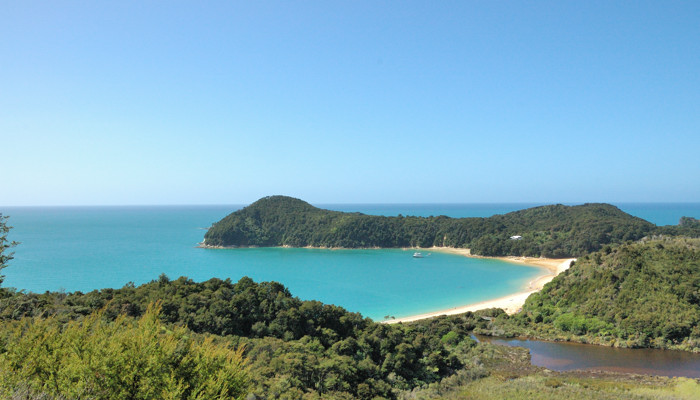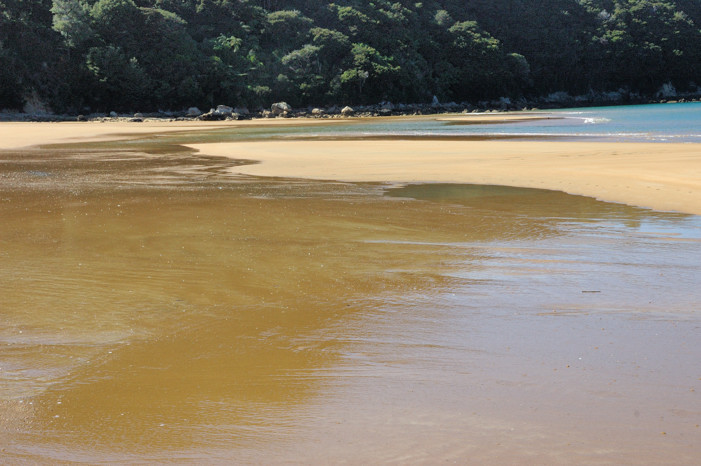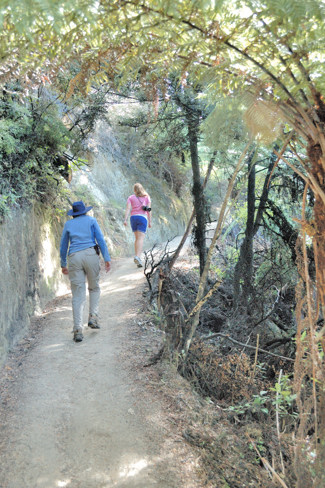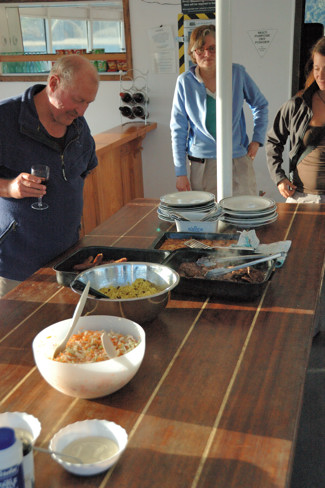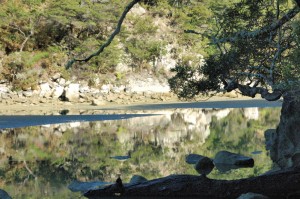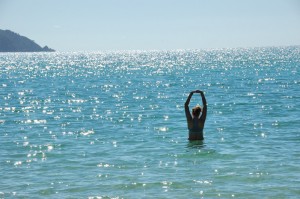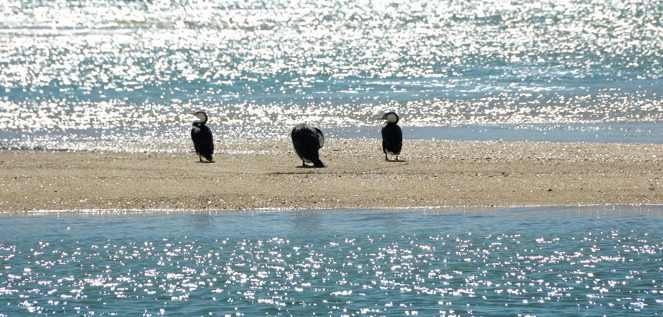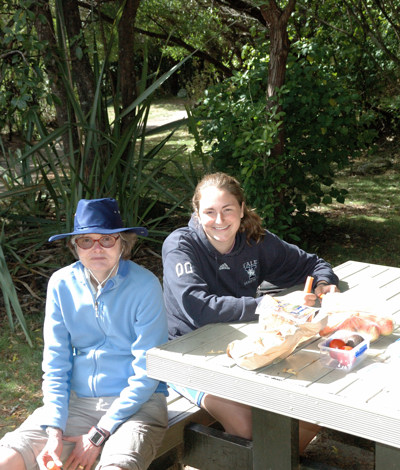 From Murchison, we drove to the north end of the south island. Our destination was Marahau, the southern gateway to the Abel Tasman national park. We parked our car there and took a water taxi north into the park to Anchorage Bay. Here we are eating lunch at a campsite there.
From Murchison, we drove to the north end of the south island. Our destination was Marahau, the southern gateway to the Abel Tasman national park. We parked our car there and took a water taxi north into the park to Anchorage Bay. Here we are eating lunch at a campsite there.
This park, the smallest of the New Zealand national parks, was created in 1942, to commemorate the two hundredth anniversary of Abel Tasman’s arrival in the area. Tasman was a Dutch seafarer, explorer, and merchant, best known for his voyages of 1642 and 1644 for the United East India Company. His was the first known European expedition to reach the islands of Tasmania and New Zealand and to sight the Fiji islands. Although the park is the home of one of New Zealand’s Great Tracks, it is, as you can see in the picture below, as much a water park as a land park, and it includes a large marine reserve.
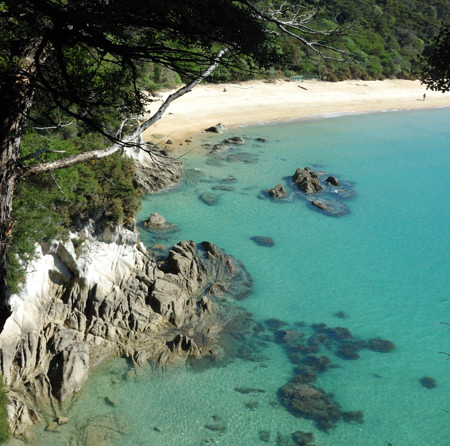 People come to this park for its clear waters, golden sand beaches, granite cliffs, and great weather. In the summer, the southern end of the park is usually crowded with visitors, many from New Zealand. But now, at the end of March, we shared the beaches and hiking trails with only a pleasant scattering of other people, despite the poor weather of yesterday having finally cleared out, giving us two fine fall days here with bright sun, highs of 80 degrees, and pleasantly warm water.
People come to this park for its clear waters, golden sand beaches, granite cliffs, and great weather. In the summer, the southern end of the park is usually crowded with visitors, many from New Zealand. But now, at the end of March, we shared the beaches and hiking trails with only a pleasant scattering of other people, despite the poor weather of yesterday having finally cleared out, giving us two fine fall days here with bright sun, highs of 80 degrees, and pleasantly warm water.
One of the attractions here is ocean kayaking. I think if we had known more about the area and had had enough flexibility in our schedule to wait out any poor weather, we would have preferred to have spent more of our time here kayaking rather than walking. This coast here is also a favorite for spot for boating, and Anchorage Bay, as its name suggests, is a place in the summer where many boats anchor.
Although it would have been fun to kayak, we certainly enjoyed the hiking and the beaches. As the photo on the left below shows, the hiking trails here are pleasantly flat. Nina particularly appreciated this, having found the rough trails we encountered on the Milford Track and elsewhere hard on her legs and feet.
Although there are several (now very expensive, even though they have no road access) houses that are grandfathered into the park, there are few accommodations other than campgrounds and DOC huts. We spent the night at one of the two, Aquacampers, a small boat moored in Anchorage Bay. It has been converted so that it has 5 double cabins – Nina and I were in one of these, a space just large enough for a double bed, which had been carved out of one side of the bridge, and two sets of 5 bunks near the waterline. Haywood slept in one of these bunks and was happy that we were onboard first so that she could pick a bunk that allowed her to extend her legs somewhat into a storage area at the foot – these bunks were quite narrow and short. Besides a place to sleep, they provided us with dinner and breakfast for a quite reasonable rate.
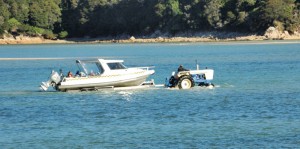 Water taxis provide an interesting way to get in and out of this park. The ones we used are specially built boats with outboard motors that can carry up to 16 people or several kayaks and somewhat fewer people. Because there are no docking facilities on the beaches of the park, these boats are essentially run up onto the beach and then, using a winch connected to the anchor, pulled back off the beach into the water. Their base in Marahau is outside of the park. However, because the harbor here does not have a deep channel and the tides are high, it also does not make sense to have docking facilities here. Instead, as you can see in the picture to the right, tractors are used to take boat trailers out into the water. When the boats come into the harbor, they are driven up onto these trailers, passengers and all. On the trailers they are then pulled onto the shore and driven down the road to the company’s base. We used a water taxi on our first day to go from Maharau to Anchorage Bay. The second morning we were picked up at Anchorage Bay and taken to Bark Bay. We walked from there 11 km to Awaroa Bay, where later, we were picked up a final time and taken back out to Marahau. The picture on the left below was taken at Bark Bay. One the right below, you can see Haywood swimming at Awaroa Bay.
Water taxis provide an interesting way to get in and out of this park. The ones we used are specially built boats with outboard motors that can carry up to 16 people or several kayaks and somewhat fewer people. Because there are no docking facilities on the beaches of the park, these boats are essentially run up onto the beach and then, using a winch connected to the anchor, pulled back off the beach into the water. Their base in Marahau is outside of the park. However, because the harbor here does not have a deep channel and the tides are high, it also does not make sense to have docking facilities here. Instead, as you can see in the picture to the right, tractors are used to take boat trailers out into the water. When the boats come into the harbor, they are driven up onto these trailers, passengers and all. On the trailers they are then pulled onto the shore and driven down the road to the company’s base. We used a water taxi on our first day to go from Maharau to Anchorage Bay. The second morning we were picked up at Anchorage Bay and taken to Bark Bay. We walked from there 11 km to Awaroa Bay, where later, we were picked up a final time and taken back out to Marahau. The picture on the left below was taken at Bark Bay. One the right below, you can see Haywood swimming at Awaroa Bay.
Awaroa Bay is the site of the second, non-camping accommodation in the park, Awaroa Lodge. We stopped there after our hike for a nice lunch. This would be a wonderful place to stay if travelling on a large budget.
We had seen shags (or cormorants in the rest of the world) in Dunedin and saw them again here. I’ll end this post with a picture of them on the Totaranui Beach at the north end of Awaroa Bay.
